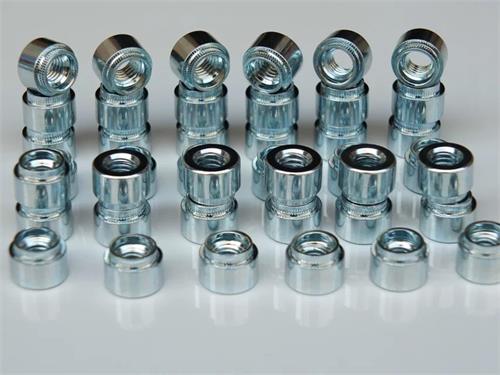First screw the self clinching nuts into the threaded mandrel and apply the guaranteed working load according to the social regulations according to Table 1, and insist on it for 15s. The rivet nut should not be tripped or cracked. When using PEM Rivet Nuts, it is necessary to confirm the A scale and the corresponding tail number Z according to the thickness of the plate and the nut standard. The user selects according to the thickness of the plate and the tail number in the table. Pressure Riveting Screw is a new type of fastener applied to thin plate or sheet metal. The principle is to press the embossing teeth into the preset hole of the sheet metal. The diameter of the general preset hole is slightly smaller than the outer diameter of the pressure riveting screw.

After pressure, the outer diameter of the pressure riveting screw is pressed into the plate to cause The periphery of the hole is plastically deformed, and the deformation is squeezed into the guide groove, thereby producing a locking effect. Riveting studs, also known as rivet studs or studs, are a kind of fasteners used in sheet metal, thin plates, chassis, and cabinets. Riveting studs have a hexagonal shape at one end and a cylindrical shape at the other end. There is an undercut in the middle of the side and the cylindrical shape, and its inner shape is an internal thread. The hexagonal head is pressed into the preset hole of the thin plate by a press to cause plastic deformation around the hole. After removing different loads, it should be possible to unscrew the rivet nut by hand, or lightly assemble the rivet nut and then unscrew it by hand. When carrying out the analytical test, the movement speed of the chuck should not exceed 3mm/min. During the test, if the threaded mandrel is damaged, the test is invalid. The hardness of the threaded mandrel should be 45HRC. The thread tolerance is 5h6g, but the diameter should be controlled within a quarter of the international range of the 6g tolerance zone close to a lower limit.
Secondly, the rivet nut is screwed into the Self Clinching Screws of the threaded mandrel, and the load is applied until it cracks. There should be no cracking at the intersection of the head and the cylindrical part; its load value should comply with the rules in Table 1. During the test, the chuck moving speed should not exceed 3mm/min. During the test, if the threaded mandrel is damaged, the test will fail.
The fourth step is to rivet the rivet nuts on the riveted plate and the screws on the test bolts without any smooth conditions. Apply torque until the rivet nut cracks or the threads are not sealed. The torque measurement error of the torque test machine or tool selected for the test shall not be greater than 2% of the relatively large additional torque. The thickness of the riveted plate and the thickness of the hole are recommended according to the product standard with relatively large rivet thickness h and d0 or s0 rules.
After the comparison, the rivet nuts were riveted on the rivet mounting plate, and the test bolts were screwed in without any lubrication. Apply torque until relative rotation occurs between the rivet nut and the rivet plate. The torque testing machine or tool used in the test should have a torque measurement error not greater than the maximum value h and d0. Find out more about self clinching fasteners on our website.
Previous: A Brief Introduction To Rivet Nuts